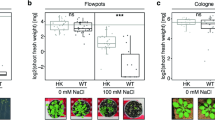Abstract
Of the many insect pests of rice, the rice green leafhopper, Nephotettix impicticeps (Motschulsky), and the brown planthopper, Nilaparvata lugens (Stål), are particularly damaging1. Light infestations reduce plant tillering, plant height, the number of productive tillers per plant and general crop vigour, and induce the production of unfilled grains. Heavy infestations cause complete drying of the crop—a condition commonly known as “hopper burn”. The economic importance of these insects has been increased by the recent discovery that they are vectors of the common Asian rice viruses. N. impicticeps carries the tungro, Penyakit merah, yellow-orange leaf and leaf yellowing viruses while N. lugens transmits grassy stunt virus2.
This is a preview of subscription content, access via your institution
Access options
Subscribe to this journal
Receive 51 print issues and online access
$199.00 per year
only $3.90 per issue
Buy this article
- Purchase on Springer Link
- Instant access to full article PDF
Prices may be subject to local taxes which are calculated during checkout
Similar content being viewed by others
References
Pathak, M. D., Annual Review of Entomology, 13, 257 (1968).
Ling, K. C., Virus Diseases of Rice Plant, 52, (International Rice Research Institute, 1968).
Author information
Authors and Affiliations
Rights and permissions
About this article
Cite this article
PATHAK, M., CHENG, C. & FORTUNO, M. Resistance to Nephotettix impicticeps and Nilaparvata lugens in Varieties of Rice. Nature 223, 502–504 (1969). https://doi.org/10.1038/223502a0
Received:
Revised:
Issue Date:
DOI: https://doi.org/10.1038/223502a0
This article is cited by
-
Rice: Nilaparvata lugens Stal interaction—current status and future prospects of brown planthopper management
Journal of Plant Diseases and Protection (2023)
-
RNA-Sequencing Reveals Differentially Expressed Rice Genes Functionally Associated with Defense against BPH and WBPH in RILs Derived from a Cross between RP2068 and TN1
Rice (2021)
-
A combined microRNA and transcriptome analyses illuminates the resistance response of rice against brown planthopper
BMC Genomics (2020)
-
High-resolution mapping and breeding application of a novel brown planthopper resistance gene derived from wild rice (Oryza. rufipogon Griff)
Rice (2019)
-
Genomic and phenotypic evaluation of rice susceptible check TN1 collected in Taiwan
Botanical Studies (2019)
Comments
By submitting a comment you agree to abide by our Terms and Community Guidelines. If you find something abusive or that does not comply with our terms or guidelines please flag it as inappropriate.



